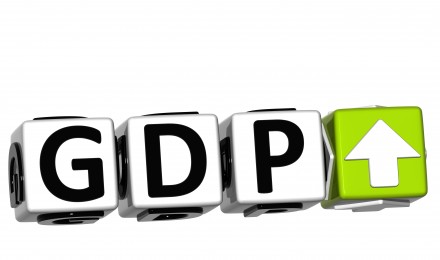In making its final estimate of gross national product (GDP) for the first quarter (Q1), the Commerce Department reports that the economy grew at a 1.8 percent annualized rate. The initial release claimed that the economy expanded at a 2.4 percent pace. The growth for Q1 still trumps the October-December quarter of 2012, when the economy nearly stalled with a miserly 0.4 percent gain.
Economists responding to the Reuters survey anticipated that the 2.4 percent growth rate for first-quarter GDP would also be the final number.
The consensus forecast for the April-June quarter calls for about a 2 percent growth rate. Economists had also predicted a stronger economy in Q3 and Q4, with growth rates of 2.5 percent and 3.0 percent, respectively.
However, the downward revisions of first quarter data will likely temper many of the predictions for GDP growth the remainder of the year.
GDP downward adjustments
The report show downward revisions of most growth sectors. Home construction and government were not affected. The data also show a surprising downward revision in consumer spending, originally estimated as 3.4 percent, it was revised to a 2.6 percent pace.
According to the report, the consumer spending revision came mainly in the form of weaker expenditures than initially estimated on health care services legal services, travel and utilities. Nonetheless, consumer spending, which makes up more than two-thirds of the U.S. economy, improved compared to Q4 2012 and despite a 2 percent hike in payroll taxes at the beginning of the year.
Slower international expansion trimmed export growth. A larger than estimated drop-off on spending for buildings resulted in a bigger decline in the business investment category.
Less government spending has obviously placed a drag on the economy–falling to an annualized rate of 4.8 percent in Q1. This metric alone reduced the original GDP estimate (2.4 percent) by 0.9 percentage points— providing the biggest negative effect on domestic economic growth.
Federal Reserve’s monetary policy
Many economists say that GDP is a lagging indicator and caution against putting too much into a “backward-looking” metric. It’s possible that the final GDP data for Q1 could cause the Federal Reserve to reconsider the timing of cut-backs in their $85 billion a month bond-purchase program.
After last week’s policy meeting, Chairman Ben Bernanke said that the Federal Open Market Committee (FOMC) had decided to scale back its bond purchases later this year. The program would end around mid-2014 only if the economy continues to improve.
The Federal Reserve’s bond-buying program has been instrumental in pushing long-term interest rates down to historic lows and helping to revive the housing market with low-interest rate loans for home buyers and and refinancing.
Depending on the GDP data from the April-June quarter—which some economists estimate will be weakened—the Fed may decide to delay cuts to the program to avoid possibly derailing the economy.
It would represent three consecutive quarters of weak economic growth, which builds a case for the Fed leaving the bond-buying program in place to support the economic recovery.
In making its final estimate of gross national product (GDP) for the first quarter (Q1), the Commerce Department reports that the economy grew at a 1.8 percent annualized rate. The initial release claimed that the economy expanded at a 2.4 percent pace. The growth for Q1 still trumps the October-December quarter of 2012, when the economy nearly stalled with a miserly 0.4 percent gain.
Economists responding to the Reuters survey anticipated that the 2.4 percent growth rate for first-quarter GDP would also be the final number.
The consensus forecast for the April-June quarter calls for about a 2 percent growth rate. Economists had also predicted a stronger economy in Q3 and Q4, with growth rates of 2.5 percent and 3.0 percent, respectively.
However, the downward revisions of first quarter data will likely temper many of the predictions for GDP growth the remainder of the year.
GDP downward adjustments
The report show downward revisions of most growth sectors. Home construction and government were not affected. The data also show a surprising downward revision in consumer spending, originally estimated as 3.4 percent, it was revised to a 2.6 percent pace.
According to the report, the consumer spending revision came mainly in the form of weaker expenditures than initially estimated on health care services legal services, travel and utilities. Nonetheless, consumer spending, which makes up more than two-thirds of the U.S. economy, improved compared to Q4 2012 and despite a 2 percent hike in payroll taxes at the beginning of the year.
Slower international expansion trimmed export growth. A larger than estimated drop-off on spending for buildings resulted in a bigger decline in the business investment category.
Less government spending has obviously placed a drag on the economy–falling to an annualized rate of 4.8 percent in Q1. This metric alone reduced the original GDP estimate (2.4 percent) by 0.9 percentage points— providing the biggest negative effect on domestic economic growth.
Federal Reserve’s monetary policy
Many economists say that GDP is a lagging indicator and caution against putting too much into a “backward-looking” metric. It’s possible that the final GDP data for Q1 could cause the Federal Reserve to reconsider the timing of cut-backs in their $85 billion a month bond-purchase program.
After last week’s policy meeting, Chairman Ben Bernanke said that the Federal Open Market Committee (FOMC) had decided to scale back its bond purchases later this year. The program would end around mid-2014 only if the economy continues to improve.
The Federal Reserve’s bond-buying program has been instrumental in pushing long-term interest rates down to historic lows and helping to revive the housing market with low-interest rate loans for home buyers and and refinancing.
Depending on the GDP data from the April-June quarter—which some economists estimate will be weakened—the Fed may decide to delay cuts to the program to avoid possibly derailing the economy.
It would represent three consecutive quarters of weak economic growth, which builds a case for the Fed leaving the bond-buying program in place to support the economic recovery.







